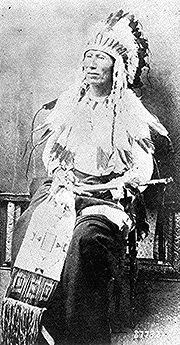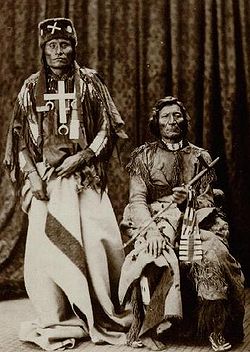
Morning Star (chief)
Encyclopedia

Cheyenne
Cheyenne are a Native American people of the Great Plains, who are of the Algonquian language family. The Cheyenne Nation is composed of two united tribes, the Só'taeo'o and the Tsétsêhéstâhese .The Cheyenne are thought to have branched off other tribes of Algonquian stock inhabiting lands...
people during the 19th century. He was noted for his active resistance to Western expansion and the Federal government. It is due to the courage and determination held by Morning Star and other Cheyenne leaders that the Northern Cheyenne still possess a homeland in their traditional country (present-day Montana
Montana
Montana is a state in the Western United States. The western third of Montana contains numerous mountain ranges. Smaller, "island ranges" are found in the central third of the state, for a total of 77 named ranges of the Rocky Mountains. This geographical fact is reflected in the state's name,...
).
Although he was known as "Dull Knife" (or Motšêške Ôhnêxahpo in Cheyenne, a translation of his Lakota name) to local settlers, U.S. military leaders, and other American Indians, his Cheyenne name is Morning Star. A Cheyenne warrior in every sense of the word, Morning Star was described by many writers of the century as "an admirable outlaw" compared to others like Rob Roy
Robert Roy MacGregor
Robert Roy MacGregor , usually known simply as Rob Roy or alternately Red MacGregor, was a famous Scottish folk hero and outlaw of the early 18th century, who is sometimes known as the Scottish Robin Hood. Rob Roy is anglicised from the Scottish Gaelic Raibeart Ruadh, or Red Robert...
and William Wallace
William Wallace
Sir William Wallace was a Scottish knight and landowner who became one of the main leaders during the Wars of Scottish Independence....
.

Treaty of Fort Laramie (1868)
The Treaty of Fort Laramie was an agreement between the United States and the Oglala, Miniconjou, and Brulé bands of Lakota people, Yanktonai Dakota, and Arapaho Nation signed in 1868 at Fort Laramie in the Wyoming Territory, guaranteeing to the Lakota ownership of the Black Hills, and further...
. Following "Custer's Last Stand" at the Battle of Little Bighorn in 1876, Morning Star allied with the Sioux
Sioux
The Sioux are Native American and First Nations people in North America. The term can refer to any ethnic group within the Great Sioux Nation or any of the nation's many language dialects...
and other tribes against the United States
United States
The United States of America is a federal constitutional republic comprising fifty states and a federal district...
. However, after a disastrous raid (the Dull Knife Fight
Dull Knife Fight
The Dull Knife Fight, or the Battle of Bates Creek, was a Great Plains battle in the Wyoming Territory between the United States Army and the Northern Cheyenne as part of the Great Sioux War of 1876-77. The battle essentially ended the Cheyennes' ability to wage war.After the battles of the Rosebud...
) by American soldiers in which 153 lodges were destroyed and 500 war ponies captured, most of the Cheyenne were eventually forced to surrender. They were transported to the Indian Territory
Indian Territory
The Indian Territory, also known as the Indian Territories and the Indian Country, was land set aside within the United States for the settlement of American Indians...
in Oklahoma
Oklahoma
Oklahoma is a state located in the South Central region of the United States of America. With an estimated 3,751,351 residents as of the 2010 census and a land area of 68,667 square miles , Oklahoma is the 28th most populous and 20th-largest state...
.
Eventually, unable to hunt, the tribe suffered from starvation and disease until September 1878 when Morning Star began to lead the tribe north back toward their ancient homelands. Fighting through, the Cheyenne were able to outmaneuver Federal troops in the Nebraska Sand Hills until they were captured near Fort Robinson
Fort Robinson
Fort Robinson is a former U.S. Army fort and a present-day state park. Located in the Pine Ridge region of northwest Nebraska, it is west of Crawford on U.S. Route 20.- History :...
in Nebraska
Nebraska
Nebraska is a state on the Great Plains of the Midwestern United States. The state's capital is Lincoln and its largest city is Omaha, on the Missouri River....
. The tribe was said to have taken apart their guns, hidden under blankets or worn as necklaces and bracelets by children. On January 8, 1879, the tribe again tried to escape north when most of the Cheyenne, mostly women and children, were killed by Federal troops. However a few of the tribe managed to escape, including Dull Knife.
Morning Star died in 1883 and was buried on a high hill at Lame Deer, Montana
Lame Deer, Montana
Lame Deer is a census-designated place in Rosebud County, Montana, United States. The population was 2,018 at the 2000 census. Lame Deer is part of the Northern Cheyenne Indian Reservation and the home of the Chief Dull Knife College. Lame Deer is the starting location of the movie Powwow...
, near the Rosebud River (now known as Stillwater River), overlooking the land where he had led his people.
Chief Dull Knife College
Chief Dull Knife College
Chief Dull Knife College is a small, open-admission, Native American tribal community college and land grant institution. It is located on the Northern Cheyenne Indian Reservation in Lame Deer, Montana, USA. Current enrollment is 141 students. More than half of its graduates move on to four-year...
in Lame Deer, Montana
Lame Deer, Montana
Lame Deer is a census-designated place in Rosebud County, Montana, United States. The population was 2,018 at the 2000 census. Lame Deer is part of the Northern Cheyenne Indian Reservation and the home of the Chief Dull Knife College. Lame Deer is the starting location of the movie Powwow...
was named in his honor.
His photograph, as Dull Knife, appears in Dee Brown's 1971 bestseller Bury My Heart at Wounded Knee
Bury My Heart at Wounded Knee
Bury My Heart at Wounded Knee by American writer Dee Brown is a history of Native Americans in the American West in the late nineteenth century. He describes the people's displacement through forced relocations and years of warfare waged by the United States federal government...
.
External links
Further reading
- Donald J. Berthrong, The Cheyenne and Arapaho Ordeal (Norman: University of Oklahoma Press, 1976).
- Stan Hoig, Perilous Pursuit (Boulder: University Press of Colorado. 2002).
- John Stands in Timber, Cheyenne Memories (New Haven: Yale University Press, 1967).

